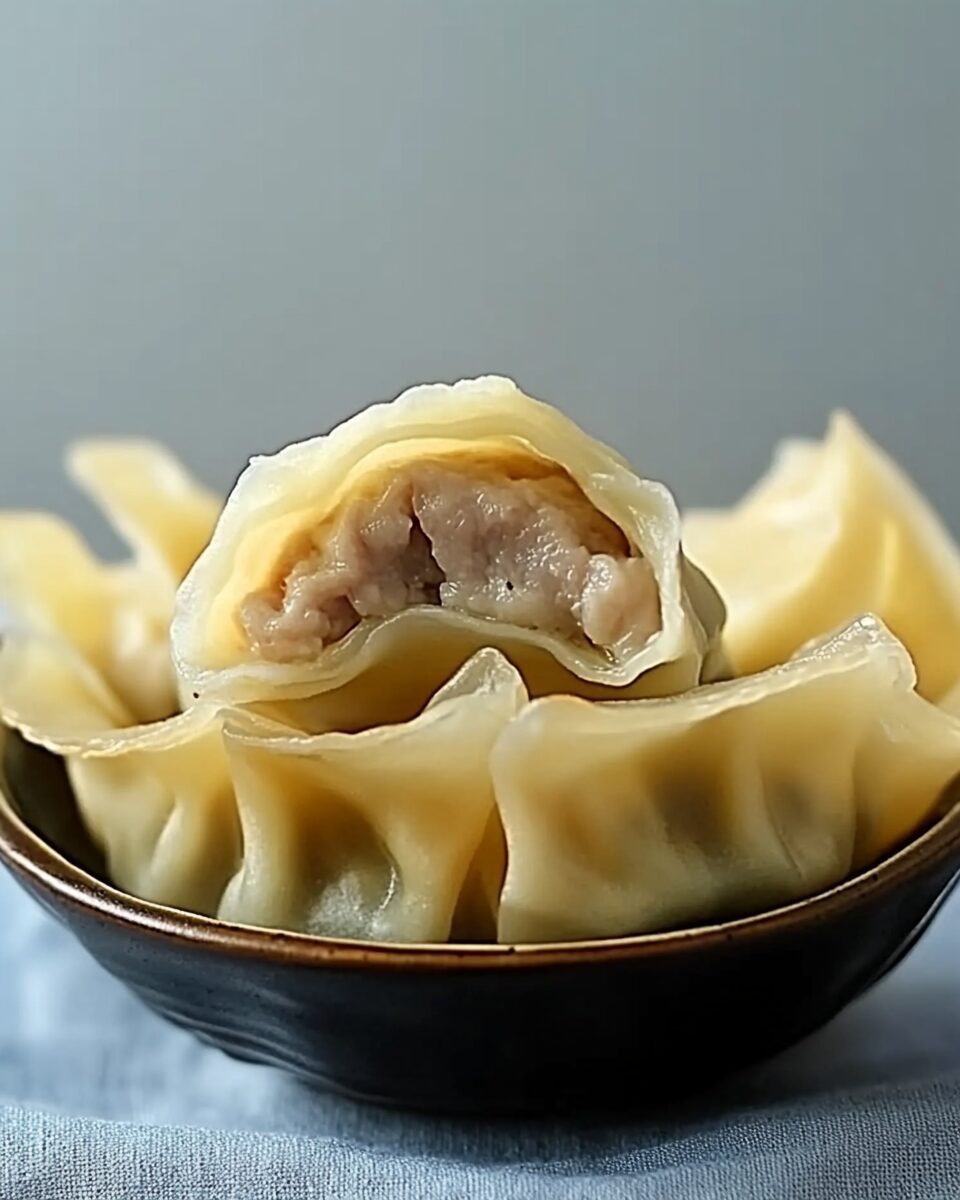Pork gyoza, often referred to as Japanese potstickers, are delectable dumplings filled with a savory mixture of ground pork, vegetables, and seasonings. These bite-sized treats are cherished for their crispy bottoms and tender tops, achieved through a unique cooking method that combines pan-frying and steaming. Whether served as an appetizer, side dish, or main course, pork gyoza offer a delightful culinary experience that captures the essence of Japanese cuisine.
Full Recipe:
Ingredients
- 12 ounces ground pork
- ¼ head cabbage, shredded
- 1 egg
- 2 spring onions, sliced
- 1 tablespoon soy sauce
- 2 teaspoons sake
- 2 teaspoons mirin
- 2 teaspoons minced fresh ginger root
- 40 gyoza wrappers, or as needed
- 2 tablespoons vegetable oil
- ½ cup water
Directions
-
Prepare the Filling:
- In a large bowl, combine the ground pork, shredded cabbage, egg, sliced spring onions, soy sauce, sake, mirin, and minced ginger. Mix thoroughly until all ingredients are well incorporated.
-
Assemble the Gyoza:
- Place a gyoza wrapper on a clean, flat surface.
- Spoon approximately 1 to 2 teaspoons of the pork mixture onto the center of the wrapper.
- Moisten the edges of the wrapper with a small amount of water.
- Fold the wrapper in half over the filling to form a semicircle.
- Pinch the edges together, creating pleats along one side to seal the gyoza securely.
- Repeat this process with the remaining wrappers and filling.
-
Cook the Gyoza:
- Heat 1 tablespoon of vegetable oil in a large skillet over medium-high heat.
- Place the gyoza in the skillet, ensuring they are not overcrowded.
- Cook until the bottoms are golden brown, approximately 3 to 5 minutes.
- Carefully pour ½ cup of water into the skillet and cover immediately.
- Allow the gyoza to steam until the water has evaporated and the filling is cooked through, about 5 minutes.
- Remove the gyoza from the skillet and set aside.
-
Serve:
- Arrange the cooked gyoza on a serving platter.
- Serve with a dipping sauce made from soy sauce and rice vinegar.
Nutritional Information
Note: Nutritional values are approximate and may vary based on specific ingredients used.
- Calories: 151 per serving
- Total Fat: 9g
- Saturated Fat: 2g
- Cholesterol: 31mg
- Sodium: 599mg
- Total Carbohydrates: 1g
- Protein: 8g
The History of Gyoza
Gyoza have their origins in Chinese jiaozi, which are dumplings that have been made for centuries. The concept of wrapping meat and vegetables in dough and cooking it has a long history in China. However, it wasn’t until the early 20th century that gyoza made their way to Japan, where they underwent a transformation. The Japanese version of gyoza differs from the Chinese version in several key ways. For instance, Japanese gyoza have a thinner wrapper and are usually pan-fried and then steamed, as opposed to being boiled.
Gyoza quickly became popular in Japan, particularly after World War II when the country saw an increase in the consumption of pork. Today, gyoza are enjoyed across Japan in various settings. They are commonly served as an appetizer or side dish in ramen shops, where they complement the hearty, rich bowls of soup. They are also popular at izakayas (Japanese pubs), where they are often served alongside beer or sake.
Why Pork?
While gyoza can be made with a variety of meats, pork remains the most traditional and popular filling. Pork offers a perfect balance of flavor and texture, especially when combined with seasonings like ginger, garlic, and soy sauce. The fat content in pork also helps to keep the filling moist and flavorful, which is key to achieving the perfect gyoza. When ground pork is mixed with finely chopped vegetables like cabbage, garlic, and onions, it creates a filling that is both savory and juicy, complementing the crispy gyoza wrapper.
That said, the versatility of gyoza means you can experiment with different fillings. For a lighter option, ground chicken, beef, or even tofu can be used. For those who prefer a vegetarian option, gyoza can be filled with a combination of vegetables like mushrooms, cabbage, and carrots. The beauty of gyoza lies in its adaptability to different tastes and dietary preferences.
The Art of Making Gyoza
Making gyoza from scratch is a rewarding experience, but it does require some patience and practice. The process involves creating the filling, assembling the dumplings, and cooking them to perfection. While this may seem daunting to a beginner, the results are well worth the effort. One of the first steps in making gyoza is preparing the filling. The mixture of ground pork, vegetables, and seasonings is key to creating a flavorful and juicy filling. You want to make sure the mixture is well-seasoned but not too wet, as the moisture can make it difficult to seal the dumplings properly.
When it comes to the dough, the key is rolling it out thin enough so that it crisps up beautifully during the frying and steaming process but thick enough to hold the filling without tearing. Gyoza wrappers can be found in most Asian grocery stores, but if you want to make them from scratch, you’ll need a simple dough made with flour and water. Once the filling is prepared and the dough is rolled out, it’s time to assemble the gyoza. The process of filling and folding the dumplings takes some practice, but with time, you’ll be able to create perfectly sealed gyoza with pleated edges, ready for cooking.
Cooking Methods: Pan-Frying and Steaming
The cooking method is what sets gyoza apart from other types of dumplings. Unlike Chinese dumplings, which are often boiled or steamed, Japanese gyoza are cooked using a combination of pan-frying and steaming. The first step is to heat a bit of oil in a skillet and fry the gyoza until the bottoms are golden and crispy. This step gives the gyoza that signature crispy texture that makes them so irresistible.
Once the bottoms are crisped up, a small amount of water is added to the pan, and the gyoza are covered to steam. The water creates steam that cooks the top of the gyoza, ensuring that the filling is fully cooked and the wrapper remains soft and tender. The key is to use the right amount of water and steam the gyoza long enough so that they are cooked through but not soggy. The result is the perfect balance of a crispy bottom and a soft, steamed top.
Serving Gyoza
Gyoza are incredibly versatile and can be served in a variety of ways. In Japan, they are typically served with a simple dipping sauce made from soy sauce, rice vinegar, and a dash of chili oil for some heat. This dipping sauce complements the rich, savory flavors of the gyoza without overpowering them. You can also serve gyoza with a side of rice or a light soup, such as miso soup, for a well-rounded meal.
Gyoza are also a great appetizer for larger gatherings. Their small size makes them easy to share and enjoy, and they pair perfectly with beer, sake, or a glass of wine. They can be served as part of a Japanese-themed dinner or as a fun addition to a party spread.
Health Benefits of Gyoza
While gyoza are not typically considered a health food, they do offer some nutritional benefits. Ground pork provides a good source of protein, and the vegetables in the filling add fiber, vitamins, and minerals. The fat in the pork helps to keep the filling moist and flavorful, but it can be reduced by using leaner cuts of meat or by substituting with chicken or tofu. If you’re concerned about calories or fat content, you can also make gyoza with less oil during cooking or opt for steaming rather than pan-frying.
In addition to being customizable in terms of filling, gyoza can be made healthier by using whole wheat wrappers or by adding more vegetables to the filling. This will increase the fiber content of the dish while still maintaining its delicious flavor and satisfying texture.
Conclusion
Pork gyoza are a beloved dish that combines rich, savory flavors with a satisfying combination of textures. The crispy, golden-brown bottoms paired with the soft, tender tops make gyoza an irresistible treat. Whether you’re making them for a weeknight meal, a party, or a special occasion, pork gyoza offer a delicious and versatile option for any meal. While they may take a bit of time and practice to perfect, the effort is well worth it, as gyoza are sure to impress your family and friends with their flavor and charm.






